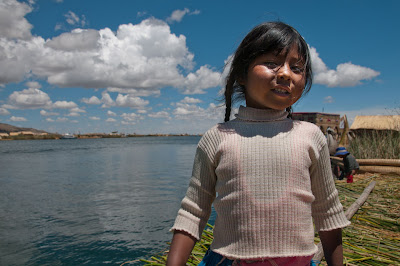driving into bolivia
The day after we got back from Titicaca, we set out on a bus to La Paz! I'd been pretty nervous about the border crossing, as there is a wealth of (mis)information floating about on the internet about the American visa needed to enter the country, but it turned out getting the stamp was probably the most straightforward part of our journey. From Puno, we piled into a slightly rickety bus packed with tourists, and drove about two hours to the border, where we hopped off, stamped ourselves out of Peru in two different offices, than walked into Bolivia (photo above courtesy of Iain) and got ourselves stamped into Bolivia. For me and all others from the States, this meant filling out a two minute form, handing over $135 in crisp American bills (they are not kidding about this one), a passport photo and a photocopy of my passport (and, despite rumors floating about the internet about proof of onward travel or yellow fever vaccines - absolutely nothing else. It was very easy, though less easy for the poor Hong Kong guy who'd been traveling with us, and who got knocked back all the way to Puno to get a proper Hong Kong visa sorted.)
From the border, we drove a few more minutes onward into beachy, lakeside Copacabana, where we had just enough time to snap a few photos and order a plate of greasy, bland french fries. Our bus had stalled and slid backwards a bit when we went up a hill into town, so we were a bit relieved to be transferring buses after lunch, at least until we saw our new bus, which was ricketier.
After about another hour, our bus stopped and we were all herded off "to buy tickets" - something that didn't make much sense until we saw that we were at a ferry port. The bus was pushed onto a giant raft, while we all piled into a smaller motorboat, narrowly beating our bus across the lake.
After a few more hours, our bus trundled over one, and then another low barrier of rocks lying in the middle of the road, the driver stopped, jumped off, and returned saying that the road was blocked and that we'd be taking an hour detour. We were some of the only tourists on the bus at this point, so I know we missed a lot of information, but we later managed to glean it was one of Bolivia's many protests blockading off the road. In any case, we turned around, spent about half an hour getting more petrol, and then proceeded to drive for about two hours over totally unpaved roads, which kicked up enough dust at times to cloud up our entire window, but which yielded some pretty gorgeous scenery.
In the end, we pulled into La Paz at about 6:30 in the evening, just in time to see the sun starting to set over the city as we descended into it. So that was our first day in Bolivia! La Paz at night felt a world away from the sleepy streets of Puno or the whitewashed buildings of Cusco, and I always get a huge rush when I set foot in a new place for the first time, so it turned out to be a pretty good, if a bit more eventful than anticipated day.






























